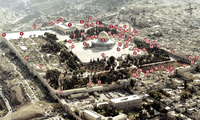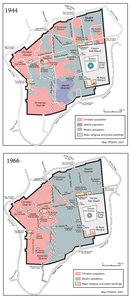THE OLD CITY, 1944 & 1966
Map Details
Archaeological findings point to settlement upon and around the site of Jerusalem’s Old City dating from ca.
4000 BCE. The major portion of the walls standing around the city today date from 1542, when their
construction was ordered by Ottoman Sultan Suleiman ‘the Magnificent’. When Britain declared Jerusalem
the administrative capital of Mandate Palestine in 1917, 22,247 souls resided within the city walls. That
year, the 900 dunum (0.9 km2) Old City, the center of religious and economic life, was made the subject of a
British decree aimed at maintaining, “in accordance with existing customs,” freedom of worship for members
all religious faiths. In 1918, the British passed an order banning any unauthorized structural alterations, “in
the city of Jerusalem or its environs within a radius of 2,500 m from the Damascus Gate.”
Thus, throughout the Mandate period, the Old City, with its principal holy places - Al-Haram Ash-Sharif, the
Church of the Holy Sepulcher, and the disputed Al-Buraq Ash-Sharif (the ‘Wailing Wall’ – see Glossary) -
remained for the most part physically unaltered. British plans for Jerusalem focused on urban and industrial
development to the west of the Old City. By 1947, 98% of Jerusalem’s Jews resided in that area, most of
them leasing land from Palestinian owners or the Waqf. Jewish Mandate-period population growth in the
western suburbs amounted to 293%, while the Jewish population in the Old City halved. Over the same
period, the number of Palestinians in the Old City, where several distinct ‘sub-communities’ lived in the
Armenian, Christian and Muslim Quarters, grew by 200%. British figures for 1944 put the population of the
Old City at 36,000; Muslims and Christians, in roughly equal proportion, numbered 33,600, while 2,400
Jews lived in a small area between the Armenian and Mughrabi Quarters. About 99.4% of the Old City was
owned by Islamic and Christian endowments or Palestinians, while 0.6% was in Jewish ownership.
During the 1947-48 War, Zionist forces were given orders to seize, expel and then settle Jewish residents in
Jerusalem’s “defeated and evacuated quarters.” The ensuing ‘transfer’ of up to 80,000 Palestinians from
their homes in Jerusalem’s western villages and suburbs created a refugee crisis of its own within the Old
City, where 30,000 ‘New City’ residents took shelter. There, Transjordanian and Palestinian forces repelled
two major Israeli assaults and succeeded in holding the walled city. The 1,300 Jewish residents who had
not fled west during the fighting were evacuated by the UN on 22 May 1948. The few houses belonging to
Jews were then leased from Jordan by UNRWA, which, together with the ICRC, administered the resettling
of refugees in these and the (more numerous) Waqf properties. In the aftermath of the war, the Old City
population dropped sharply, as many residents had been dispossessed of their livelihood and land beyond
the walls and sought new opportunities in Amman, where development was more focused or other family
members had taken refuge during and after the war.
In June 1967, the Israeli army occupied the Old City, along with the rest of the West Bank. Israel pledged to
“safeguard the city’s integrity and to live in it with others in unity.” However, the first Friday following its
conquest, Israel ordered prayer at Al-Haram Ash-Sharif halted - the first such instance in nearly 800 years.
The following day, 10 June, 650 residents of the 14th Century Mughrabi Quarter were expelled beyond the
city limits and their homes bulldozed to make way for a plaza in front of the Wailing Wall. In 1968, in the
face of condemnation and UN demands that it, “rescind all measures already taken and desist forthwith
from taking any action which would alter the status of Jerusalem,” Israel proceeded to demolish another
1,048 flats, 437 workshops, four schools and two mosques, forcing over 6,000 Palestinians from the city
and establishing today’s Jewish Quarter. The Jewish Quarter, hailed by Israel as a ‘return’ to the Old City,
consumed 116 dunums of the Old City - more than 23 times the total area in pre-1948 Jewish ownership.
The population of the Old City in 1967 was put at 23,675, a figure revealing a steep decline since Mandate
times. Most of the population loss was the result of socio-economic factors stemming from the 1947-48 War
and migration to the East Bank in the years that followed. Others had fled the fighting in 1967 - for the West
Bank hinterland or east across the Jordan - and were to be prevented from returning. By the end of 1968,
Israel’s mass ejections from the Old City had further reduced the Palestinian population by more than 25%.
Related Maps

ISRAEL'S SEPARATION BARRIER, 2002
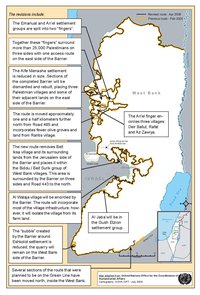
REVISED ROUTE OF THE ISRAELI SEPARATION BARRIER, 2006
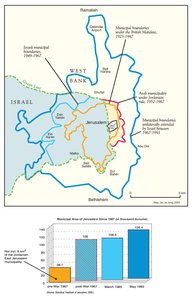
MUNICIPAL BOUNDARIES OF JERUSALEM, 1947-2000
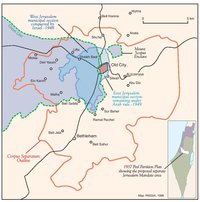
JERUSALEM AND THE CORPUS SEPARATUM PROPOSED IN 1947
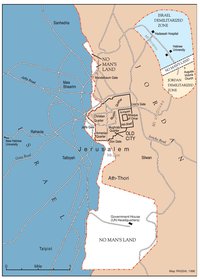
PARTITIONED JERUSALEM, 1948-1967
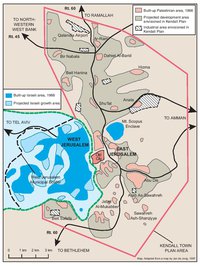
THE KENDALL TOWN SCHEME, 1966
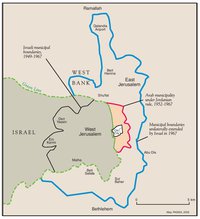
JERUSALEM AFTER THE 1967 WAR
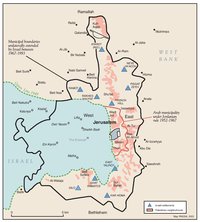
ISRAELI SETTLEMENTS AND PALESTINIAN NEIGHBORHOODS IN EAST JERUSALEM, 2000
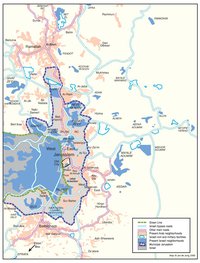
ISRAELI SETTLEMENTS AND PALESTINIAN NEIGHBORHOODS IN METROPOLITAN JERUSALEM, 2000
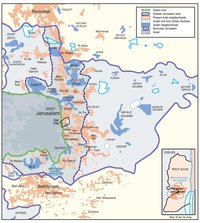
ARAB EAST JERUSALEM WITHIN ‘GREATER’ JERUSALEM, 2000
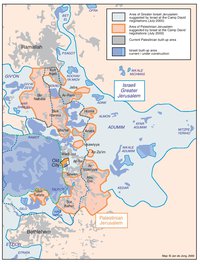
PROJECTION OF THE ISRAELI PROPOSAL FOR JERUSALEM’S FINAL STATUS AT CAMP DAVID, JULY 2000
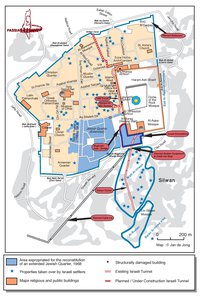
SETTLEMENT ACTIVITY IN THE OLD CITY
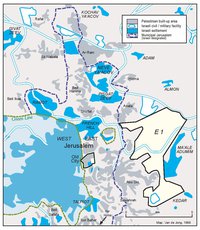
THE E-1 DEVELOPMENT PLAN
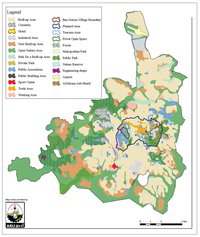
THE JERUSALEM MASTER PLAN
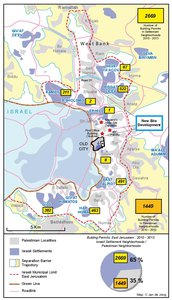
JERUSALEM TODAY (2014)
